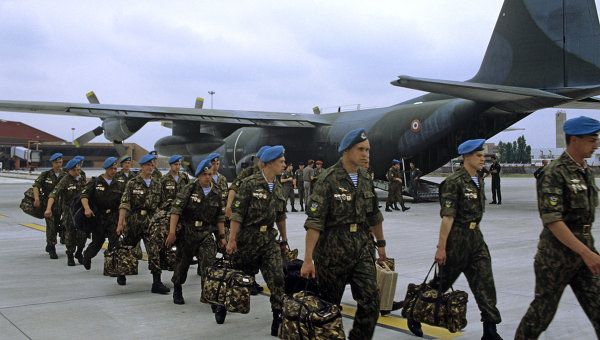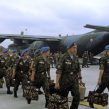
Moscow Promotes Airpower and Peacekeeping on Afghanistan-Linked CSTO Agenda (Part Two)
Publication: Eurasia Daily Monitor Volume: 10 Issue: 86
By:

Following the creation in June 2009 of the rapid reaction forces to enhance the military capabilities of the Collective Security Treaty Organization (CSTO), Uzbekistan’s departure from the body in 2012 and the prospect of the North Atlantic Treaty Organization’s (NATO) drawdown in Afghanistan, Moscow is trying to further boost the CSTO by developing airpower and peacekeeping capacities currently lacking. These moves are linked to the success Moscow has achieved in elevating the significance of Afghanistan on the CSTO’s agenda (see EDM, April 30).
According to the commander of the Russian and CSTO airbase at Kant near Bishkek, Colonel Igor Mordovkin, Moscow will expand the size and scope of the base linked to 2014 and NATO’s drawdown in Afghanistan. Mordovkin sees the logic in this base expansion, since it serves as the only base in Central Asia that offers air cover for the CSTO rapid reaction forces and would become an essential part any future CSTO military operations in the region. Although he did not specify the precise nature of the expansion of the Kant airbase, sources in the Russian embassy in Bishkek anticipate that it will “be impressive” (Nezavisimoye Voyennoye Obozreniye, April 17).
A critical link in this sequence of CSTO force development ties the creation of the Collective Air Force to the expansion of the Kant airbase. This means that, if the CSTO Air Force is established, the Kant airbase will “constitute the first international military installation of collective defense in the post-Soviet area.” It was precisely this issue that was the subject of discussion during the CSTO Permanent Council meeting on April 15–16. Attendees to the meeting included CSTO Secretary-General Nikolai Bordyuzha; chief of the organization’s Joint Staff, Lieutenant-General Aleksandr Studenikin; Russian Ambassador to Kyrgyzstan Andrey Krutko; and the Kyrgyz Republic’s military leadership. One signal that these plans are serious was supplied by the use of military transport aircraft to assist in assembling the officials at Koy-Tash for the meeting—previous meetings had involved only civilian airliners (Nezavisimoye Voyennoye Obozreniye, April 17).
“Bordyuzha has repeatedly talked about the inclusion of Afghanistan within the CSTO’s zone of responsibility. Like Serbia, the country has been granted observer status at the CSTO’s Parliamentary Assembly. Evidently, therefore, it is not ruled out that, following the departure of the International Security Assistance Force from Afghanistan, Kabul will officially request military assistance from the collective defense organization. And our combat aviation will be just what is needed here,” Colonel Eduard Rodyukov, a corresponding member of the Academy of Military Sciences, noted. Significantly, the base commander Colonel Mordovkin explained that the aircrews are training for operations in mountainous terrain, potentially linking the airbase expansion and the creation of a Collective Air Force to possible operations inside Afghanistan post-2014 (Nezavisimoye Voyennoye Obozreniye, April 17).
Some additional clues concerning the reality of these plans to boost the airpower component of the CSTO were provided by no less an authority than Colonel-General Vladimir Shamanov, the commander of Russia’s elite Airborne Forces. Shamanov advocates uniting the newly formed Special Operations Forces, as well as the Airborne Troops, marine units and Spetsnaz brigades as a rapid reaction force and forming a separate mobile military district: Russia’s fifth military district. Shamanov said these views have been discussed with the new leadership of the defense ministry, and this may signal an additional departure from the reform of the Armed Forces conducted under the guidance and mismanagement of Anatoly Serdyukov in 2008–2012 (https://ria.ru/interview/20130424/934203290.html).
“It is my firm belief that the new structure, let us call it, say, a rapid reaction force, under a single command and under the direction of the General Staff, should consolidate the Airborne Troops, Special Operations Forces, and include operationally subordinate Spetsnaz brigades and marine formations and units in coastal areas. Then, [the Russian Federation], with 50,000 kilometers of land borders and surrounded on three sides by seas and oceans, will have, in addition to four static operational-strategic commands, its fifth, mobile operational-strategic command, which will make it possible to respond to threats in a comprehensive manner both inside and outside the country,” Shamanov explained (https://ria.ru/interview/20130424/934203290.html).
Observers of the CSTO’s recent development have frequently puzzled over Moscow’s references to the creation of CSTO peacekeeping forces. However, General Shamanov shed light on this issue, explaining that by June 1, 2013, the Airborne Forces’ 31st Guards Airborne Assault Brigade would be fully transformed into a peacekeeping brigade and that by September 1, 2013, four airborne divisions will possess peacekeeping battalions (https://ria.ru/interview/20130424/934203290.html).
Thus, Shamanov and senior Russian defense officials are representing force development in the CSTO, both on airpower based in Central Asia and forming peacekeeping forces under the CSTO, in terms of ensuring post-2014 regional security. Inadvertently, this discussion reveals continued disparity between commanders, such as Shamanov, and the Russian defense ministry leadership on what to do with Serdyukov’s mess in reforming the Armed Forces. Adding new military districts or creating additional forces such as Russian rapid reaction forces seems plausible, but is certainly a departure from the Serdyukov era. Equally, Russian defense planning linked to Afghanistan after 2014 seems to envisage boosting the number of assets and personnel located at the Kant airbase, which appears to be predicated upon Moscow expecting Manas to close.




